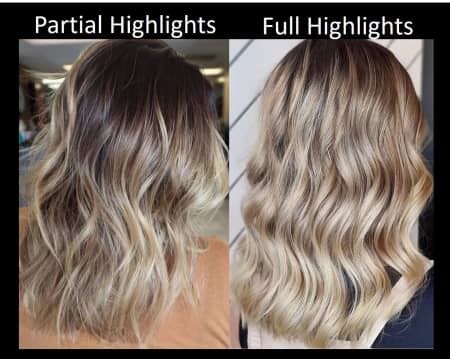Introduction
Hair highlighting is a popular technique that adds dimension and vibrancy to hair. Whether you’re seeking a subtle or a dramatic transformation, understanding the differences between partial highlights and full highlights is crucial. This comprehensive guide will delve into the nuances of each method, empowering you to make an informed decision about your next hair appointment.

Partial highlights, also known as balayage or babylights, involve strategically placing highlights in sections of your hair. This technique creates a natural-looking, sun-kissed effect without overwhelming your overall hair color. Partial highlights are ideal for those who desire a low-maintenance and subtle color enhancement.
Benefits of Partial Highlights:
- Natural-looking: Mimics the gradual lightening of hair due to sun exposure.
- Versatile: Can be customized to suit various hair types and styles.
- Low-maintenance: Requires less frequent touch-ups compared to full highlights.
- Hair-healthier: Less damaging as it avoids extensive bleaching of the entire hair.
Drawbacks of Partial Highlights:
- Less dramatic: Provides a more subtle change in hair color than full highlights.
- Can be time-consuming: The application process often takes longer due to the targeted highlighting.
- Not suitable for drastic color changes: Cannot achieve significantly lighter shades than your natural hair color.
Full highlights involve bleaching or coloring the entire head of hair. This technique offers a bolder, more dramatic color transformation. Full highlights are perfect for those willing to embrace a more eye-catching hair color and are not concerned about potential hair damage.
Benefits of Full Highlights:
- Dramatic color change: Offers a drastic alteration in hair tone, allowing for vibrant or high-contrast colors.
- Even distribution: Distributes color evenly throughout the hair, resulting in a cohesive look.
- Suitable for drastic changes: Can lighten hair significantly, even from dark to blonde shades.
- Can disguise gray hair: Effectively covers gray hair with a more uniform color.
Drawbacks of Full Highlights:
- High-maintenance: Requires frequent touch-ups to maintain vibrancy and prevent root growth.
- Hair-damaging: Extensive bleaching can compromise hair health, leading to dryness and breakage.
- Can be expensive: The cost of full highlights is typically higher than partial highlights due to the increased time and materials required.
| Feature | Partial Highlights | Full Highlights |
|---|---|---|
| Color Distribution | Strategic placement in sections | Even throughout the hair |
| Color Effect | Natural-looking, subtle | Dramatic, bold |
| Maintenance | Low-maintenance | High-maintenance |
| Hair Damage | Less damaging | Can be damaging |
| Versatility | Customizable to various hair types | Suitable for most hair types |
| Cost | Typically lower | Typically higher |
When selecting between partial and full highlights, consider these factors:
- Desired Color Change: Partial highlights provide a subtle transformation, while full highlights offer a more dramatic change.
- Hair Health: Partial highlights are less damaging than full highlights, especially if you have fine or fragile hair.
- Lifestyle: Partial highlights are lower-maintenance, making them ideal for busy individuals or those who prefer a more natural look.
- Budget: Full highlights typically cost more than partial highlights, so factor this into your decision.
Partial highlights offer several advantages over full highlights:
- Natural-looking: Mimics the gradual lightening of hair due to sun exposure.
- Versatile: Can be customized to suit various hair types and styles.
- Low-maintenance: Requires less frequent touch-ups compared to full highlights.
- Hair-healthier: Less damaging as it avoids extensive bleaching of the entire hair.
Full highlights provide unique benefits compared to partial highlights:
- Dramatic color change: Offers a drastic alteration in hair tone, allowing for vibrant or high-contrast colors.
- Even distribution: Distributes color evenly throughout the hair, resulting in a cohesive look.
- Suitable for drastic changes: Can lighten hair significantly, even from dark to blonde shades.
- Can disguise gray hair: Effectively covers gray hair with a more uniform color.
Q: Can I do partial highlights at home?
A: Home highlighting can be challenging, and it’s recommended to seek professional assistance to achieve optimal results and minimize damage.
Q: How often should I get partial highlights?
A: Touch-ups are typically needed every 8-12 weeks to maintain vibrancy and blend in root growth.
Q: Can I get partial highlights on dark hair?
A: Yes, partial highlights can be used on dark hair, but the level of lightening achieved may be more gradual.
Q: Are partial highlights cheaper than full highlights?
A: Generally, yes, partial highlights require less time and materials, resulting in a lower cost.
Q: Which is better for fine hair, partial or full highlights?
A: Partial highlights are better suited for fine hair as they minimize damage and provide a more natural-looking effect.
Q: Can I get full highlights on short hair?
A: Yes, full highlights can be applied to short hair, but the placement and distribution of highlights may need to be adjusted to suit the shorter length.
Whether you opt for partial or full highlights, the key to a successful hair transformation lies in understanding the unique benefits and considerations associated with each method. By choosing the technique that best aligns with your desired color change, hair health, and lifestyle, you can achieve a stunning new look that enhances your natural beauty.
